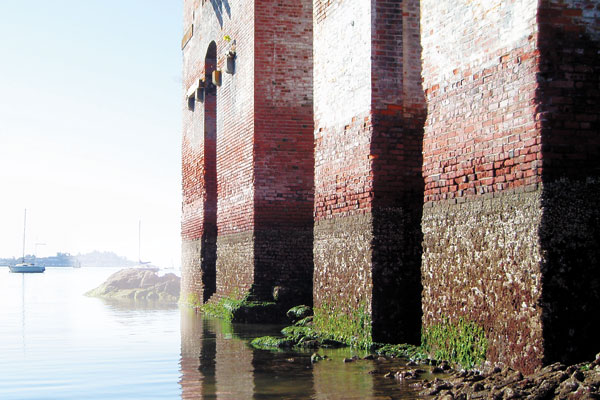Pair of Cole Island buildings slated for renovation
By Lookout on Sep 30, 2016 with Comments 0

A view of the 1890s shell store houses located on Esquimalt Harbour’s Cole Island. Photo courtesy of Province of B.C. Heritage Branch
Peter Mallett, Staff Writer ~
A historical ammunition depot, located on the tiny, rocky outcrop in Esquimalt Harbour called Cole Island, is being restored.
More than 150 years ago, the remote island was chosen to house ammo because of its distance from the naval hub, and was named after Edmond Picoti Cole, master of HMS Fisgard. By the end of the Second World War the depot was no longer required.
The island has been undergoing a transformation since 2006 when it was recognized as a National Historic Site by the Historic Sites and Monuments Board of Canada.
Prior to that point, the 150-year-old buildings had fallen into a state of disrepair as the area was visited by partiers, vandals and those wanting to dump their refuse.
The two brick and timber buildings at the heart of this phase of restoration were built around 1859 and once housed shells and other ammo.
The Province of British Columbia, the custodian of the Cole Island, and Parks Canada are pumping $200,000 into the renovation, with upgrades being carried out under the guidance of B.C.’s Ministry of Forests Lands and Natural Resource Operations Heritage Branch.
The branch is currently researching what the two buildings looked like by sifting through old navy correspondence, reviewing 1940s era RCAF aerial photographs, and hearing from residents and employees who frequented the site through the Friends of Cole Island network.
“We want to find out how far the balconies, which were used to load ammunition, extended into the water and what the buildings looked like from the seaward side,” says Richard Linzey, Heritage Branch manager. “We have begun to mobilize and get on the island to do the work, so any new information would be termendous.”
Work done to date includes emergency repairs to four of the magazines used for the storage of gunpowder, cartridges, shells, mines, rockets and small arms ammunition, and a guardhouse. Surface remains of 15 other buildings pepper the landscape, as does the remnants of a garden containing international plant species and an intricate fire hydrant system.
Cole Island is accessible by boat and foot at low tide and does not feel like a provincial or national park.
“Putting picnic benches and toilets would take away from the uniqueness and the discovery factor of visiting the island,” says Linzey. “There is a sense of mystery when you are out there because the history is not presented to you; it just unfolds as you tour around.”
Linzey, who spent 14 years working as an architect in the U.K. for the non-profit English Heritage, says the guard house is thought to be the oldest military masonry structure in British Columbia.
“We even have correspondence on file from Colonel Richard Clement Moody of the Royal Engineers about the erection of the island’s first buildings,” says Linzey. “It’s quite extraordinary to see with your own eyes how the Royal Navy would have the wherewithal and the confidence to construct these buildings in such a far-flung location halfway around the world from Britain.”
Linzey credited the Friends of Cole Island and its many volunteers for ridding the island of trash and graffiti, and raising the importance of restoration to the local community. Their primary responsibility is security, surveillance and maintenance of the island, and they work closely with the Province, the City of Colwood, The Town of View Royal, the Queen’s Harbour Master and the Royal Canadian Navy to achieve those ends.
“From the beginning our goal has always been to maintain a focus on the island and advocate for its safe-keeping,” says the Friends of Cole Island founder Linda Carswell. “The restoration work that has taken place over the past few years and the upcoming work has been carefully researched and planned to reflect the original site. It’s a respectful approach and many of the people involved in the restoration work are just as passionate about Cole Island as we are.”
Approximately 25 post-graduate students from the University of Victoria have been involved in the restoration work as part of a course offered by their Cultures, Museums and Indigenous Studies program called Cultural Resource Management.
They are using the repairs made on the island as examples of conservation work, and the mechanisms of decay that have occurred in the structures as teaching tools for other historical sites. The research they gather will be used to inform what materials and restoration work should be performed.
Linzey says his office is still looking for more information about the Cole Island site and encourages any individuals who may have images or knowledge of the island to contact him at Richard.Linzey@gov.bc.ca
Filed Under: Top Stories
About the Author:





